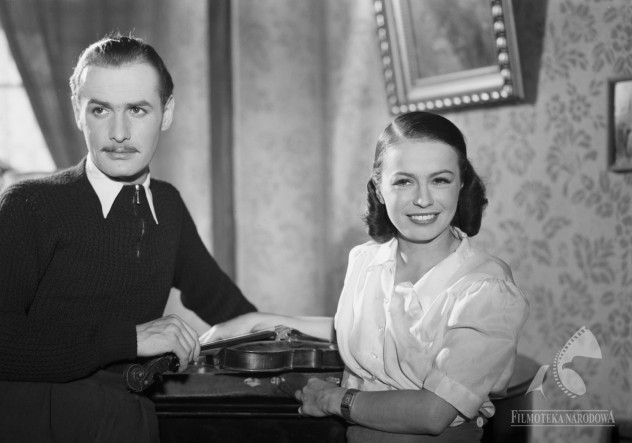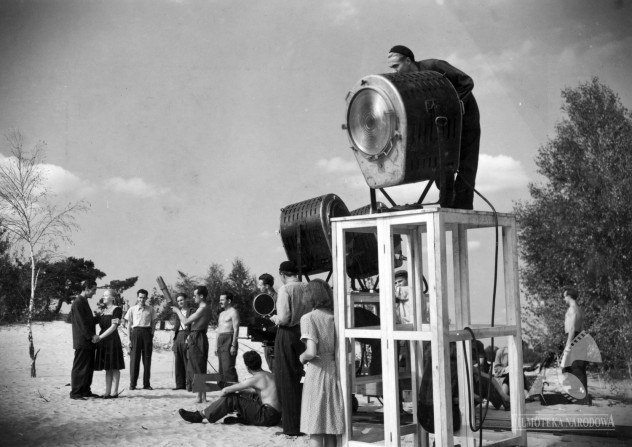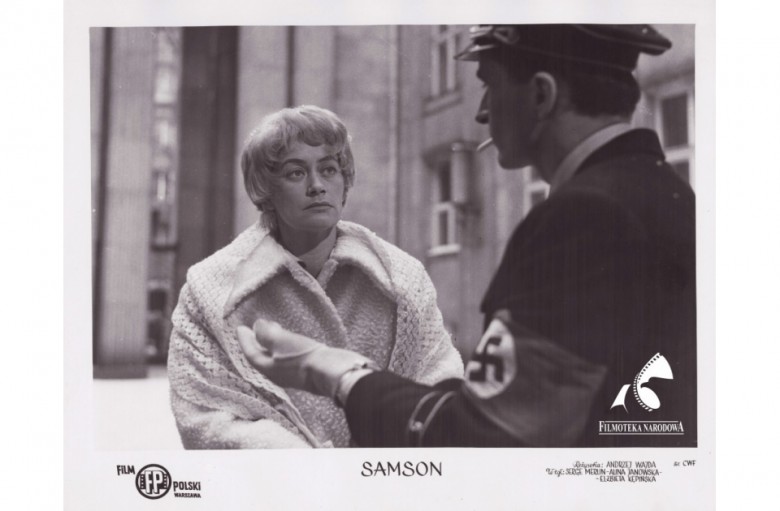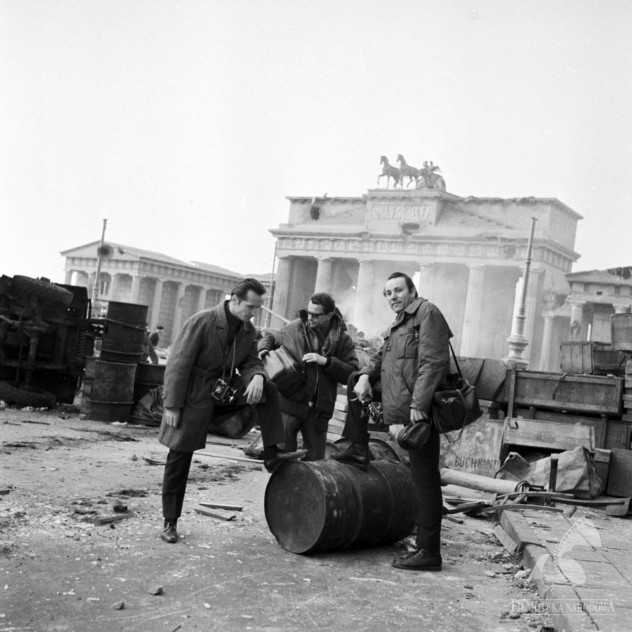foto mix
HISTORY OF POLISH FILM STILL PHOTOGRAPHY
Paper film stills become a thing of the past. Only from time to time the “Femina” cinema in Warsaw or the “Jutrzenka” cinema in Krynica put up a paper still on a special noticeboard, but that form of promotion has become a relic. The market has been dominated by digital stills, while the Internet is the main marketing medium. A poster is the only traditional form that is used today, although it has changed, too.
Of course, there is no need to be concerned, because a paper film still will not disappear completely. In 2011, seeing the exhibition of film stills by Renata Pajchel at the Film Festival in Gdynia, I thought that in the near future old paper film stills would probably be used on special occasions - such as exhibitions. And maybe for some film-fans or collectors, they would become equally valuable as vinyl for music lovers.
Sometimes it is said that the history of film stills is as long as the history of film. In the case of Polish film still photography, however, it is difficult to trace back to its origin and determine when first film stills were taken. Usually there are no stills for first silent films. The advertisement of the small company “Moderne” said that it made stills since 1911, but it is difficult to verify as before WWII almost all companies operating in the sector claimed to be the oldest and the most experienced company. Some information may be found in the press of that time. In 1914, in the “Kino, teatr i sport” magazine, a still from the film “Słodycz grzechu” by Edward Puchalski was published and it was quite a novelty at that time, as almost all film advertisements published then were written, decorated with ornamented letters to draw readers’ attention. Late 1910’s and early 1920’s a film still was still a curiosity in the press. For some more years, “Ilustrowany Kurier Codzienny” published drawings of actors instead of their photographs. As late as mid-1920’s, a film still became an integral element of articles on films and of film advertisements, and, prior to numerous film premieres, it was used in film postcards (they had characteristic frames and fonts) presenting the most interesting scenes and actors.

Advertisement for the Moderne company
The change was probably caused by the fact that at that time, the following companies professionally dealing film stills started their intensive operation: Fotos, Stephot and Foto Forbert. It was also the time of first professional still photographers. Film photographs were mainly taken in the “Falanga” and “Sfinks” ateliers , but photographers more and more often took stills in the open air. Two of them, Leonard Zajączkowski and Maksymilian Frankfurt (by the way - owner of Stephot), made film stills a kind of art, so it is not a surprise that they quickly dominated the market of film photography1, and earned due recognition for the profession. Film schedules often included information about film still authors; photos were also usually marked with authors’ names or at least the name of the company that provided photographic services. In the case of films of particular importance, as e.g. “Pan Tadeusz” by Ryszard Ordyński that was created on the occasion of the 10th anniversary of restoration of Poland’s independence, film stills received an exceptional graphic form. In Muzeum Kinematografii in Łódź, there is the complete set of stills for “Pan Tadeusz” with ornamented frames and fragments of Mickiewicz’s epics engraved on them.
Before WWII, studio portraits were another branch of photography indirectly related to film. In Warsaw, there were several places regularly visited by artists and film stars: first of all, Benedykt Dorys and Van Dyck’s ateliers - both in Aleje Jerozolimskie - where Eugeniusz Haneman who passed away early 2014 did his training as a young boy, or the atelier of Leonard Zajączkowski in Leszno. At that time photo sessions were very popular, almost all film stars wanted to have professional pictures. On the other hand, the press used them as magazine covers and in this way influenced the popularity of individual actors.
A lot of those photographs were destroyed during WWII. The collection of Zajączkowski’s negatives burnt completely during the Warsaw Uprising, and the collection of pre-war film stills of Filmoteka Narodowa is still not complete. Fortunately, a lot of photographs is being found in private archives, even today, several decades after WWII ended.
In 1945, in a new political environment, when the entire film industry was organised from scratch, the film still sector also required organisation. In Wytwórnia Filmowa Wojska Polskiego in Łódź, there was an organisation gathering photographers, while Przedsiębiorstwo Państwowe “Film Polski” initially included Agencja Fotograficzna. In June 1945, Aleksander Ford asked Marek Frankfurt, a photographer, to go to Bydgoszcz and organise production in the “Alfa” factory which manufactured film and photographic accessories2.
Besides Frankfurt, a few experienced and novice photographers appeared in Łódź after WWII; they created foundations for the film still branch: Kazimierz Wawrzyniak, a young amateur photographer, became the head of the lab in Narutowicza street, Mieczysław Biełous, a photographer, was employed as a lab assistant, Jerzy Gaus, who had worked as a still photographer before WWII and an employee in “Stephot”, accompanied cinematographers of Polish Film Chronicles and prepared photo reportages presenting their work, while Wojciech Urbanowicz, who worked in a photo studio before the war, started taking first stills - e.g. for the short film “Nawrócony” by Jerzy Zarzycki. Soon they all dealt with still photography. Frankfurt worked for “Zakazane piosenki” and “Jasne łany”, Wawrzyniak for e.g. “Skarb” and “Czarci żleb”, Gaus for, among others, “Ulica graniczna” and “Stalowe serca”, Urbanowicz for e.g. “Robinson warszawski” and “Dom na pustkowiu”, while Biełous for e.g. “Gromada” and “Celuloza”.

A film still for "Zakazane piosenki", the first post-war feature film. Photographed by Marek Frankfurt
In their work, they usually used heavy sheet film cameras using 13x18 sheet films. Such equipment was not very mobile and required a tripod; therefore the work of a still photographer hindered the work of a film crew. After shooting was finished, a crew had to wait for over 10 minutes for a photographer to take stills of actors posing in set decorations. “Either Mr Biełous or another still photographer arranged the scene according to their needs - recalls Kurt Weber, a cinematographer - which involved discussions with actors or a lighting director who was asked to adjust the lighting arrangement in a manner corresponding to still photographers’ ideas. As a result, taking stills consumed a lot of time and made it difficult for directors and cinematographers to meet their deadlines. Still photographers were not welcomed on sets, they were treated as a visit to the dentist: it was necessary, but everybody was happy when it was over”3. Therefore stills from 1940’s and 1950’s resemble theatre photography to a certain extent. However, they are not devoid of their charm, and, thanks to large-size sheet film, they are of high quality.
It is difficult to say why there are so few “werk” stills of that time, i.e. on-the-set production photos presenting film crews at work. In the case of such photos, a still photographer did not have to interrupt the work of a crew; he could take them e.g. during dress rehearsals. Maybe werk stills were not taken because of a pre-war tradition - a still photographer exclusively focused on actors, and not on a crew. However, it is more likely that werks were taken short after WWII, but when negatives were developed and prints were produces, they were considered as materials of lower value. As a result, in the case of films of 1940’s, there are usually around ten werks that were delivered to Centralne Archiwum Filmowe (today: Filmoteka Narodowa) in special albums.

On-the-set production still from the film "Dom na pustkowiu", one of the few such stills from that time to be acquired by the National Film Archive. Photographed by Wojciech Urbanowicz
It seems that at that time the work of a film crew was mainly interesting to... crew members themselves who took photos of their colleagues on a set using their own cameras. Those private photos have recently surfaced more and more often - e.g. in the book about his artistic work, Leszek Wronko, an outstanding sound technician, published very interesting photographs taken on the sets of “Zakazane piosenki” and “Jasne łany”4, while the book “Fabryka snów” by Stanisław Zawiśliński and Tadeusz Wijata includes over a dozen of unknown photographs showing the work of film-makers just after shooting had been finished - i.e. during film and sound editing5.
The attitude towards werk stills changed as late as in the end of 1940’s and in the beginning of 1950’s. At that time, the “Film” weekly started to publish short articles discussing the work of film-makers on a film set - illustrating them with werks from Polish films. Maybe still photographers realised then that werks might be interesting to some people. Among original still negatives to films released after 1950 that are deposited in Filmoteka Narodowa, there are a lot of valuable werk stills.
Short after WWII, a still photographer took around three hundred photographs to one film. In 1950’s, when medium-format cameras 4,5x6 became more and more wide-spread, the number of photographs taken in relation to one film was as high as one thousand, and in the case of blockbusters such as “Krzyżacy” - even up to two thousand. A still photographer developed index print of each frame of a negative where he/she marked how the frame was to be cropped and then, together with a director, selected pictures for the so-called marketing kit (by film-makers called Satz) of which thousands of copies were made and sent to the press and placed in cinemas’ noticeboards. Advertisement stills were easy to identify - they always had a special frame or a bar with a film title and director’s name written in bold. The look of frames changed; the most attractive one was probably in 1950’s and 1960’s. Unfortunately, today nobody remembers who designed them.

An original film still with distinctive border and inscriptions
Mid-1950’s the status of still photographer changed. Earlier, his/her name was almost always presented in opening credits. For a still photographer, taking stills was a defined and automatic film job. Since mid-1950’s cinematographer’s assistants have gradually taken over the function of a still photographer and took photos as part of their work on a set. “The trivial saying is: »if you don’t know what’s about, it is probably about money«” - explained Edward Zajiček, an outstanding historian of Polish film production. “Still photographers were not paid well. Moreover, it was believed that everybody could take a photograph, especially a cinematographer assistant. Such people were ordered to take photographs after they performed their basic duties. In contrast, a photographer being a member of authors association and an owner of copyright was bound by a price list of minimum rates (otherwise he/she was excluded from the association).6"
As a result, it was cheaper to employ a lay still photographer, and the activity of taking stills become something less important. The work was performed by someone who had just graduated from a film academy and was entrusted first tasks within the cinematography section. For some people, taking stills was the first step on their way to become a cinematographer. The following people started their professional careers as still photographers: Jerzy Stawicki, Franciszek Kądziołka, Wiesław Zdort, Marek Nowicki, Andrzej Ramlau or Edward Kłosiński. Their names were not presented in opening credits, they were just mentioned as cinematographer assistants. Out of professional still photographers, probably only Wojciech Urbanowicz lived through the change and continued to perform his job, although in opening credits of some films his name was also described as “Cinematographer assistant”.
Time in which a still was ready also became more and more important. Publishing one reportage from a set of a Polish film every week, the “Film” or “Ekran” weeklies had to have photos from such sets. A still photographer was not able to deliver them within just a few days. Therefore, since around 1958, the film press employed its own photojournalists who visited sets for one or two days and take photos of scenes that were shot at that time. Names such as Roman Sumik, Jerzy Troszczyński, Tadeusz Kubiak and Romuald Pieńskowski dominated the film photojournalism for over ten subsequent years. Later on, they were followed by others - e.g. Jerzy Kośnik who won the competition for the post of a photojournalist in “Film” late 1970’s.

On the set of the film "Ostatnie dni" [The Last Days]. Carrying their photo cameras are: Romuald Pieńkowski, Roman Sumik and Jerzy Troszczyński
A photojournalist perceived the situation on a set in a totally different manner than a still photographer: he or she was an outsider, took photos of actors from a perspective other than they were shot in a specific scene with a film camera, and a crew was usually friendly towards him or her because they knew that his or her photographs would be published in the press after a few days and would be an advertisement of their unfinished film. Moreover, from the very beginning photojournalists used good 6x6 film cameras, while traditional still photographers, although gradually started to use such cameras, sometimes had to bring heavy 13x18 cameras on a set by as late as 1963.
Photojournalists revived film photography and the process of taking stills on sets itself. When Renata Pajchel entered the profession, film still photography changed even more. There is a certain peculiarity in her photographs, as if they were in the very centre of a situation pictured. Pajchel has always followed the principle that a photo should be cropped while it is taken in such a way that you don’t have to do it again later. And although in the beginning she was suggested to stand farther from an object and not to cut off tops of people’s heads, she liked “cutting off tops of heads”7. As a result, her stills are probably the closest representation of an actor’s metamorphosis on the set, of what an actor’s face expresses. Pajchel regularly worked together with e.g. Andrzej Wajda and Krzysztof Zanussi. It was said that a director that engages her will be successful at least in terms of photographic service for his/her film.
In 1980’s, Krzysztof Wellman became an equally successful and recognised still photographer. Unfortunately, when their stills were put up on noticeboards and published in the press in relation to premieres, only a few people could recognise their real quality. Starting in early 1970’s, the manner of copying and paper of advertisement stills became worse and worse. Objects’ contours were fuzzy, grey colour dominated, there were no clear black and white contrasts, and even if a still was in colour, it lost its quality quite quickly because of the so-called “orwo effect”. Only today, when original negatives of stills of that time are digitised by use of special scanners, it is possible to see them from a new perspective and notice their mastery.
After the breakthrough of 1989, the “Polfilm” company was liquidated8. It dealt with production and distribution of film stills. Its role had to be taken over by film studios and private producers that entered the market. At that time, the job of a still photographer became recognised again, still photographers’ names appeared in film credits again and were also printed in the press next to still reproductions. Several large photo companies specialising in film stills were established soon - first of all, “Fabryka Obrazu” owned by Piotr Bujanowicz which also today provides photographic services for the majority of Polish films.
On the other hand, the status of film photojournalists decreased. After Sumik and Pieńkowski died mid-1990’s, “Film” and other film magazines practically resigned from photo reportages from sets. “Maciej Pawlicki, then chief editor of »Film«, wanted to transform the magazine into a magazine following western patterns with perfect images - explains Bożena Janicka, a long-standing head of home affairs section of the magazine. “He did not like Sumik’s journalistic photographs and probably looked at on-the-set journalistic photos from that perspective. Journalistic photos were always of test character and played an auxiliary role in relation to films, while Maciek was not interested in playing such a role in relation to Polish film but to make a magazine that follows western patterns. He wanted to have more articles on foreign films, and when they had to be about Polish ones, then they had to be accompanied by the best photographs, so they had to be taken by a still photographer of a particular film”9. Other magazines also used stills only and did not engage their own photojournalists. Film photo reportage almost died in the press. Today, when news from a set is published, it is accompanied by few photographs.
Piotr Śmiałowski
1. Cf. L. Perski, Leonard Zajączkowski – wspomnienie o operatorze, interview by H. Rutkowska, „Ekran”, 1979, no. 12
2. The information in this paragraph is based on the letter written by Edward Zajček on 26 January 2014 and a document of Centralna Dyrekcja Filmu Polskiego from Archiwum Akt Nowych, 366/10, file 102, sheet 10
3. Kurt Weber’s letter of 4 February 2014
4. M. Dondzik, Leszek Wronko. Dźwięk polskiego filmu, Łódź 2013
5. S. Zawiśliński, T. Wijata, Fabryka snów, Łódź 2013
6. Letter of Edward Zajček of 26 January 2014
7. Cf. A . Wyżyński, Zawód: fotosista, „Filmpro”, October 2012
8. “Polfilm” was established in 1965 as a result of the merger of Państwowe Zakłady Fotoprzezroczy and Ośrodek Usług Filmowych i Reklamy Kinowej.
9. Interview with Bożena Janicka of December 2013







































